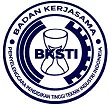Preventing musculoskeletal disorders due to manual material handling in the production process of clean water
Abstract
Keywords
Full Text:
PDFReferences
A. C. Whittaker et al., “Daily stair climbing is associated with decreased risk for the metabolic syndrome,” BMC Public Health, vol. 21, no. 1, pp. 4–9, 2021, doi: 10.1186/s12889-021-10965-9.
S. Tsitsifli and V. Kanakoudis, “Determining Hazards’ Prevention Critical Control Points in Water Supply Systems,” Environ. Sci. Proc., p. 53, 2020, doi: 10.3390/environsciproc2020002053.
J. Lundqvist, E. Lavonen, G. Mandava, E. Selin, H. Ejhed, and A. Oskarsson, “Effect-based monitoring of chemical hazards in drinking water from source to tap: seasonal trends over 2 years of sampling,” Environ. Sci. Eur., vol. 36, no. 1, 2024, doi: 10.1186/s12302-024-00875-z.
A. Asrun, L. M. Zamrud, and I. P. Sudayasa, “Faktor-Faktor Risiko yang Berhubungan dengan Kejadian Gangguan Pendengaran pada Karyawan Tambang,” Medula J. Ilm. Fak. Kedokt. Univ. Halu Oleo, vol. 1, no. 1, pp. 14–19, 2013.
S. Parmawati and D. N. Nugraheni, “Hubungan Kebisingan terhadap Stress pada Pekerja Bagian Produksi di Perusahaan Tekstil,” J. Syntax Transform., vol. 4, no. 1, pp. 32–39, 2023, doi: 10.46799/jst.v4i1.680.
S. I. Sukma, M. Muis, and E. Ibrahim, “The Influence of Noise and Hot Work Climate on Fatigue through Work Pulse on Workers of Production Division at PT . Maruki International Indonesia Makassar in 2019,” East African Sch. J. Educ. Humanit. Lit., vol. 2, no. 11, pp. 672–677, 2019.
L. R. Sari, S. Sadi, and I. Berlianty, “Pengaruh Lingkungan Kerja Fisik Terhadap Produktivitas Dengan Pendekatan Ergonomi Makro,” Opsi, vol. 12, no. 1, p. 48, 2019, doi: 10.31315/opsi.v12i1.2939.
C. E. Ekpenyong and U. C. Inyang, “Associations between worker characteristics, workplace factors, and work-related musculoskeletal disorders: A cross-sectional study of male construction workers in Nigeria,” Int. J. Occup. Saf. Ergon., vol. 20, no. 3, pp. 447–462, 2014, doi: 10.1080/10803548.2014.11077057.
N. M. Dewantari, A. R. Fachrur, A. S. Mariawati, R. Akbari, M. Ferdiansyah, and F. C. Annisa, “Design of LPG transport aids to prevent musculoskeletal risks,” J. Ind. Serv., vol. 9, no. 1, p. 47, 2023, doi: 10.36055/jiss.v9i1.19047.
F. Mohammadipour, M. Pourranjbar, S. Naderi, and F. Rafie, “Work-related Musculoskeletal Disorders in Iranian Office Workers: Prevalence and Risk Factors,” J. Med. Life, vol. 11, no. 4, pp. 328–333, 2018, doi: 10.25122/jml-2018-0054.
L. G. Halsey, D. A. R. Watkins, and B. M. Duggan, “The Energy Expenditure of Stair Climbing One Step and Two Steps at a Time: Estimations from Measures of Heart Rate,” PLoS One, vol. 7, no. 12, 2012, doi: 10.1371/journal.pone.0051213.
L. Lady, “Assessment Comfortability of Climbing Stairs and the Height of Building Stair,” no. 2018, pp. 2803–2810, 2021.
T. P. Huang and A. D. Kuo, “Mechanics and energetics of load carriage during human walking,” Journal of experimental biology, Jan. 2013, doi: 10.1242/jeb.091587.
M. Tenaga, K. Dan, T. Republik, K. Tenaga, K. Dan, and D. A. N. Fungsi, “Republik Indonesia Republik Indonesia,” vol. 2013, no. 021, pp. 1–266, 2010.
Health and Safety Authority, Guidance on the Management of Manual Handling in the Workplace. 2005. [Online]. Available: http://www.hsa.ie/eng/Publications_and_Forms/Publications/Occupational_Health/Guidance_Manual_Handling.pdf
K. Schultz and J. J. Galante, “Ergonomic guidelines for manual material handling,” 8th Annu. Appl. Ergon. Conf. Proc., pp. 1021–1060, 2005.
W. E. B. Links, “Web links,” Nurs. Manage., vol. 10, no. 5, pp. 31–31, 2003, doi: 10.7748/nm.10.5.31.s21.
S. M. Taghavi, H. Mokarami, O. Ahmadi, L. Stallones, A. Abbaspour, and H. Marioryad, “Risk factors for developing work-related musculoskeletal disorders during dairy farming,” Int. J. Occup. Environ. Med., vol. 8, no. 1, pp. 39–45, 2017, doi: 10.15171/ijoem.2017.861.
W. M. Keyserling, M. Brouwer, and B. A. Silverstein, “A checklist for evaluating ergonomic risk factors resulting from awkward postures of the legs, trunk and neck,” Int. J. Ind. Ergon., vol. 9, no. 4, pp. 283–301, 1992, doi: 10.1016/0169-8141(92)90062-5.
A. N. Ichsani and R. Fitriadi, “Perancangan Alat Bantu Pada Aktivitas Manual PalletizingDengan Pendekatan Ergonomi di PT. Tirta Investama Klaten,” Semin. dan Konf. Nas. IDEC, 2023.
DOI: http://dx.doi.org/10.62870/jiss.v10i1.24471
Refbacks
- There are currently no refbacks.
 is supported by
is supported by








